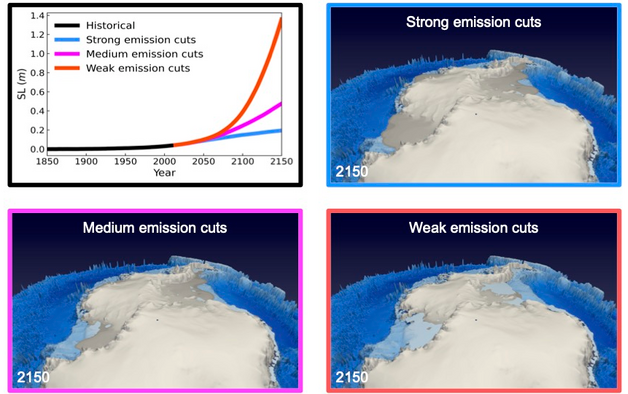Recent research carried out by an international group of researchers reveals that irreversible loss of the West Antarctic and Greenland ice sheets, as well as a related rapid acceleration of sea level rise, could be inevitable if the global temperature change is not stabilized below 1.8 °C relative to preindustrial levels.
 Sea level rise contributions from the Antarctic and Greenland ice sheets, and maps of projected 2150 CE Antarctic ice sheet surface elevation following different greenhouse gas emission scenarios (SSP1-1.9, strong emission cuts; SSP2-4.5, medium emission cuts; SSP5-8.5, weak emission cuts). Image Credit: Institute for Basic Science Jun-Young Park.
Sea level rise contributions from the Antarctic and Greenland ice sheets, and maps of projected 2150 CE Antarctic ice sheet surface elevation following different greenhouse gas emission scenarios (SSP1-1.9, strong emission cuts; SSP2-4.5, medium emission cuts; SSP5-8.5, weak emission cuts). Image Credit: Institute for Basic Science Jun-Young Park.
The study was published in the journal Nature Communications.
Coastal populations worldwide have already been gearing up for rising sea levels. However, preparing for countermeasures to inhibit inundation and other impacts have been incredibly difficult because the latest climate model projections presented in the Intergovernmental Panel on Climate Change’s (IPCC) 6th assessment report do not agree on how rapidly the significant ice sheets will respond to global warming.
Melting ice sheets are likely the largest contributor to sea level rise and have historically been the most difficult to predict due to the physics governing their behavior.
Moreover, computer models that simulate the dynamics of the ice sheets in Greenland and Antarctica often do not account for the fact that ice sheet melting will affect ocean processes, which, in turn, can feed back onto the ice sheet and the atmosphere.
Jun Young Park, Study First Author and PhD Student, Center for Climate Physics, Institute for Basic Science
Jun Young Park is also a student at the Pusan National University, Busan, South Korea.
The group of climate researchers discovered that an ice sheet/sea level runaway effect can be avoided only if the world achieves net zero carbon emissions before 2060, using a new computer model that incorporates for the first time the coupling between icebergs, ice sheets, ocean, and atmosphere.
If we miss this emission goal, the ice sheets will disintegrate and melt at an accelerated pace, according to our calculations. If we don’t take any action, retreating ice sheets would continue to increase sea level by at least 100 cm within the next 130 years. This would be on top of other contributions, such as the thermal expansion of ocean water.
Axel Timmermann, Study Co-Author, Professor, and Director, Center for Climate Physics, Institute for Basic Science
Ice sheets react to atmospheric and oceanic warming in unexpected and delayed ways. Earlier, researchers emphasized the significance of subsurface ocean melting as a vital process that can cause runaway effects in Antarctica’s vital marine-based ice sheets.
However, according to our supercomputer simulations, the effectiveness of these processes may have been overestimated in recent studies. We see that sea ice and atmospheric circulation changes around Antarctica also play a crucial role in controlling the amount of ice sheet melting with repercussions for global sea level projections.
June Yi Lee, Study Co-Author and Professor, Center for Climate Physics, Institute for Basic Science
June Yi Lee is also associated with the Pusan National University.
The research reflects the need for more complex earth system models that capture the various climate components and their interactions. Moreover, new observational programs, particularly from highly active regions like the Pine Island glacier in Antarctica, are required to constrain the representation of physical processes in earth system models.
“One of the key challenges in simulating ice sheets is that even small-scale processes can play a crucial role in the large-scale response of an ice sheet and for the corresponding sea-level projections. Not only do we have to include the coupling of all components, as we did in our current study, but we also need to simulate the dynamics at the highest possible spatial resolution using some of the fastest supercomputers,” concluded Axel Timmermann.